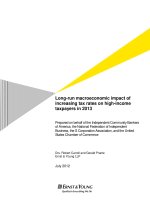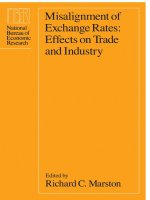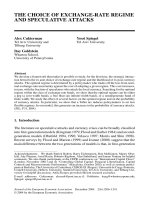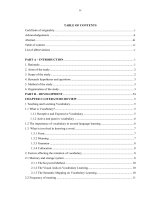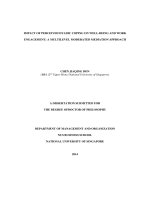IMPACT OF EXCHANGE RATE POLICY ON VIETNAM
Bạn đang xem bản rút gọn của tài liệu. Xem và tải ngay bản đầy đủ của tài liệu tại đây (683.67 KB, 28 trang )
FOREIGN TRADE UNIVERSITY
FACULTY OF ENGLISH FOR SPECIFIC PURPOSES
---------***--------
INTERNATIONAL BUSINESS ENGLISH THESIS
IMPACT OF EXCHANGE RATE POLICY ON VIETNAM
TRADE BALANCE IN 1999-2018 PERIOD
Topic number: 3
Group: 13
Class: TAN432(1-1920).3 _LT
Lecturer: MSc. Phan Kim Thoa
Hanoi, September 2019
LIST OF MEMBERS
Name
Student code
Presentation
Lê Khánh Linh
1611110335
Part 1.1
Nguyễn Thị Nguyệt Ánh
1611110066
Part 1.2, 1.3
Trần Hoàng Dũng
1611110117
Part 2.1
Trần Minh Thu (Leader)
1611110558
Part 2.2, 2.3
Nguyễn Thị Thu Hà
1611110165
Chapter 3
1
Table of Contents
Table of Contents ........................................................................................................................ 2
Abstract ....................................................................................................................................... 3
Introduction ................................................................................................................................. 4
Chapter 1. General theory ........................................................................................................... 5
1.1.
Exchange rate ............................................................................................................. 5
1.1.1.
Definition of exchange rate ................................................................................. 5
1.1.2.
Classification of exchange rate ........................................................................... 5
1.1.3.
Main factors influencing exchange rate ............................................................. 6
1.2.
Exchange rate policy .................................................................................................. 7
1.2.1.
Definition of exchange rate policy ...................................................................... 7
1.2.2.
Classification of exchange rate policy ................................................................ 8
1.3.
Trade balance ............................................................................................................. 9
1.3.1.
Definition.............................................................................................................. 9
1.3.2.
The relationship between exchange rate and balance of trade ........................ 10
Chapter 2. Impacts of exchange rate policy on Vietnam trade balance since 1991 - today ..... 13
2.1. Exchange rate policy from 1999 – 2015 and its effect on Vietnam trade
balance .............................................................................................................................. 13
2.1.1.
The period from 1999 to 2007 ........................................................................... 13
2.1.2.
The period from 2008 to 2010 ........................................................................... 14
2.1.3.
The period from 2011 to 2015 ........................................................................... 16
2.2.
Exchange rate policy from 2016-2018 and its effect on Vietnam trade balance
19
2.3.
Evaluation of exchange rate policy in 1999-2018 period .................................. 21
Chapter 3. Recommendations ................................................................................................... 23
3.1.
Effects of passed exchange rate policies and future market trend .................. 23
3.2.
Approaches to an appropriate exchange rate policy ......................................... 24
Summary ................................................................................................................................... 26
References ................................................................................................................................. 27
2
Abstract
This paper investigates the impact of the exchange rate policy on trade
balance in Vietnam from 1999 to 2018. The paper compares the exchange rate
policies over the period and the results show that exchange rate in different period
affects differently on the export and import volume. The paper shows that the
implementation of central exchange rate has positive impact on Vietnam trade
balance after the long-lasting period of trade deficit. The paper concludes by
suggesting some policy implications in managing the exchange rate system and
promoting exports of Vietnam.
3
Introduction
Exchange rate has played a very important role in international trade, especially
in such a great open world economy. Many countries pursue a development strategy
using exchange rate as a main intervention, which is called the export-led growth model.
Vietnam is one among the countries pursuing such strategy. The exports sector has
experienced a structural change due to greater integration into the world economy.
Although globalization and trade liberalization has been beneficial for Vietnam, it also
increases the exposure to external shocks. Besides, one of main duties of exchange rate
tool facilitating trade balance, stays remained despite the fact that the exchange rate
regime has been adjusted many times during the last 20 years. Notably, when the
authority adjusts the exchange rate, they will have to face other unexpected impacts,
given that there has existed twin deficits for a long time – trade balance deficit and budget
deficit. This paper aims to deal with the question of effectiveness of exchange rate policy
on trade balance, the time period chosen is from 1999 to 2018.
The paper is organized as followed: In the first chapter, we will give some
rudimentary knowledge of the exchange rate and foreign exchange policy. Chapter 2
will take a closer look into the impacts of exchange rate policy on Vietnam trade balance
from 1999 to 2018, and we conclude by putting forward some possible
recommendations to enhance the effectiveness of foreign exchange market in the last
chapter.
The purpose of this study is to help address Vietnam’s exchange rate policy since
1999 and its consequences for trade balance of Vietnam. In pursuing these objectives,
this study mainly employs analytical review and synthesis method of analysis, to provide
an analysis of different but inter-related aspects of exchange rate policy and trade balance
of Vietnam.
4
Chapter 1. General theory
1.1. Exchange rate
1.1.1. Definition of exchange rate
An exchange rate is the rate at which one currency will be exchanged for another.
It is also regarded as the value of one country’s currency in relation to another currency.
For example, an interbank exchange rate of 23.150 Vietnam dong to the United States
dollar means that VND23.150 will be exchanged for each US$1 or that US$1 will be
exchanged for each VND23.150. In this case it is said that the price of a dollar in relation
to Vietnam dong is VND23.150, or equivalently that the price of a Vietnam dong in
relation to dollars is $1/23.150.
1.1.2. Classification of exchange rate
Flexible or Floating exchange rate systems: are ones whereby the rate of a
currency is determined by the market forces of demand and supply. Unlike the fixed
exchange rate they do not derive their value from any underlying. Some economists
argue that a floating system is more preferable since it absorbs the shocks of a global
crisis and automatically adjusts to arrive at an equilibrium.
A forward rate: is a one that is determined as per the terms of a forward contract.
It stipulates the purchase or sale of a foreign currency at a predetermined rate at some
date in the future. A forward contract is generally entered into by exporters and
importers who are exposed to Forex fluctuations. The forward rate is quoted at a
premium or discount to the spot price.
The spot rate: is the current exchange rate for any currency. It is the rate at which
your currency shall be converted if you decided to execute a foreign transaction “right
now”. They represent the day-to-day exchange rate and vary by a few basis points every
day.
5
Dual exchange rate: In this type of system, the currency rate is maintained
separately by two values-one rates applicable for the foreign transactions and another
for the domestic transactions. Such systems are normally adopted by countries who are
transitioning from one system to another. This ensures a smooth changeover without
causing much disruption to the economy.
1.1.3. Main factors influencing exchange rate
Inflation Rates: Changes in market inflation cause changes in currency exchange
rates. A country with a lower inflation rate than another's will see an appreciation in the
value of its currency. The prices of goods and services increase at a slower rate where
the inflation is low. A country with a consistently lower inflation rate exhibits a rising
currency value while a country with higher inflation typically sees depreciation in its
currency and is usually accompanied by higher interest rates
Interest Rates: Changes in interest rate affect currency value and dollar exchange
rate. Forex rates, interest rates, and inflation are all correlated. Increases in interest rates
cause a country's currency to appreciate because higher interest rates provide higher rates
to lenders, thereby attracting more foreign capital, which causes a rise in exchange rates
Country’s Current Account / Balance of Payments: A country’s current account
reflects balance of trade and earnings on foreign investment. It consists of total number
of transactions including its exports, imports, debt, etc. A deficit in current account due
to spending more of its currency on importing products than it is earning through sale of
exports causes depreciation. Balance of payments fluctuates exchange rate of its
domestic currency.
Government Debt: Government debt is public debt or national debt owned by the
central government. A country with government debt is less likely to acquire foreign
capital, leading to inflation. Foreign investors will sell their bonds in the open market if
6
the market predicts government debt within a certain country. As a result, a decrease in
the value of its exchange rate will follow.
Terms of Trade: Related to current accounts and balance of payments, the terms of
trade is the ratio of export prices to import prices. A country's terms of trade improves if
its exports prices rise at a greater rate than its imports prices. This results in higher
revenue, which causes a higher demand for the country's currency and an increase in its
currency's value. This results in an appreciation of exchange rate.
Political Stability & Performance: A country's political state and economic
performance can affect its currency strength. A country with less risk for political turmoil
is more attractive to foreign investors, as a result, drawing investment away from other
countries with more political and economic stability. Increase in foreign capital, in turn,
leads to an appreciation in the value of its domestic currency. A country with sound
financial and trade policy does not give any room for uncertainty in value of its currency.
But, a country prone to political confusions may see a depreciation in exchange rates.
Recession: When a country experiences a recession, its interest rates are likely to
fall, decreasing its chances to acquire foreign capital. As a result, its currency weakens
in comparison to that of other countries, therefore lowering the exchange rate.
Speculation: If a country's currency value is expected to rise, investors will demand
more of that currency in order to make a profit in the near future. As a result, the value
of the currency will rise due to the increase in demand. With this increase in currency
value comes a rise in the exchange rate as well.
1.2. Exchange rate policy
1.2.1. Definition of exchange rate policy
The exchange rate policy refers to the manner in which a country manages its
currency in respect to foreign currencies and the foreign exchange market. The exchange
rate is the rate at which the domestic currency can be converted into a foreign currency.
7
In turn, this affects the costs of domestic production and finance relative to foreign
products and capital. In formulating exchange rate policy, a balance must be found
between several differing, and sometimes conflicting, objectives. In particular, the use
of the exchange rate to promote the competitiveness of domestically-produced goods
must be considered alongside the implication for the international purchasing power of
the currency and, in particular, the impact of changes in the exchange rate on domestic
inflation
1.2.2. Classification of exchange rate policy
There are two major regime types: One is fixed (or pegged) exchange rate
regimes. The other one is floating (or flexible) exchange rate regimes.
Floating rate
A floating (or flexible) rate is a system in which currencies have no specific par
value; value is normally determined by supply and demand. Central bank are not required
to intervene, but they often do to avoid wild fluctuations.
A floating (or flexible) rate is determined by the open market through supply and
demand on global currency markets. Therefore, if the demand for the currency is high,
the value will increase. If demand is low, this will drive that currency price lower. Of
course, several technical and fundamental factors will determine what people perceive
is a fair exchange rate and alter their supply and demand accordingly.
A floating (or flexible) exchange rate policy is one in which a country's exchange
rate fluctuates in a wider range and the country's monetary authority makes no attempt
to fix it against any base currency. A movement in the exchange is either an appreciation
or depreciation.
There are two types of floating rate:
8
Free float: Free float, also known as clean float, signifies that a currency's value
is allowed to fluctuate in response to foreign-exchange market mechanisms without
government intervention.
Managed float (or dirty float): Managed float, also known as dirty float, involves
government intervention in the market exchange rate in different forms and degrees, in
an attempt to make the exchange rate change in a direction conducive to the economic
development of the country, especially during an extreme appreciation or depreciation.
A monetary authority may, for example, allow the exchange rate to float freely between
an upper and lower bound, a price "ceiling" and "floor."
Fixed rate
A fixed exchange rate, sometimes called a pegged exchange rate, is one in which
a monetary authority pegs its currency's exchange rate to another currency, a basket of
other currencies or to another measure of value (such as gold), and may allow the rate to
fluctuate within a narrow range. To maintain the exchange rate within that range, a
country's monetary authority usually needs to intervenes in the foreign exchange market.
A movement in the peg rate is called either revaluationor devaluation.
A fixed (or pegged) rate is determined by the government through its central bank.
The rate is set against another major world currency (such as the U.S. dollar, euro, or
yen). To maintain its exchange rate, the government will buy and sell its own currency
against the currency to which it is pegged. Some countries that choose to peg their
currencies
to
the
U.S.
dollar include
China
and
Saudi
Arabia.
(the currency is tied to another currency, mostly reserve currencies such as the U.S.
dollar or the euro or the British Pound Sterling or a basket of currencies)
1.3. Trade balance
1.3.1. Definition
9
Balance of trade is the international trading position of a country in merchandise,
excluding invisible trade. If exports are greater than imports there is a surplus (or
favourable balance of trade).
The balance of trade, commercial balance, or net exports (sometimes symbolized
as NX), is the difference between the monetary value of a nation's exports and imports
over a certain time period. Sometimes a distinction is made between a balance of trade
for goods versus one for services. The balance of trade measures a flow of exports and
imports over a given period of time. The notion of the balance of trade does not mean
that exports and imports are "in balance" with each other.
A country that imports more goods and services than it exports in terms of value
has a trade deficit. Conversely, a country that exports more goods and services than it
imports has a trade surplus. The formula for calculating the balance of trade can be
simplified as the total value of imports minus the total value of exports.
NX = I - E
NX: balance of trade
I: imports value
E: exports value
For example, if the United States imported $1.5 trillion in goods and
services in 2017, but exported only $1 trillion in goods and services to other
countries, then the United States had a trade balance of -$500 billion, or a
$500 billion trade
deficit.
$1.5 trillion in imports - $1 trillion in exports = $500 billion trade deficit
1.3.2. The relationship between exchange rate and balance of trade
The balance of trade influences currency exchange rates through its effect on the
supply and demand for foreign exchange. When a country's trade account does not net
10
to zero – that is, when exports are not equal to imports – there is relatively more supply
or demand for a country's currency, which influences the price of that currency on the
world market. However, the relationship between exchange rate and trade balance is
indecisive both in long run and short run. Commercial companies often trade fairly small
amounts compared to those of banks or speculators, and their trades often have a little
short-term impact on market rates. Nevertheless, trade flows are an important factor in
the long-term direction of a currency's exchange rate.
Trade Balance Influences Exchange Rate
These relative values are influenced by the demand for currency, which is influenced
by trade. If a country exports more than it imports, there is a high demand for its goods,
and thus, for its currency. The economics of supply and demand dictate that when
demand is high, prices rise and the currency appreciates in value. In contrast, if a country
imports more than it exports, there is relatively less demand for its currency, so prices
should decline. In the case of currency, it depreciates or loses value.
For example, let's say that electronic components are the only product on the market
and Vietnam imports more electronic components from the USA than it exports, so it
needs to buy more dollars relative to VND sold. Vietnam's demand for USD outstrips
America's demand for VND, meaning that the value of the VND falls. In this situation,
we'll surmise that VND might fall to 20,000 relative to the dollar. Now, for every $1
sold, an American gets 20,000 VND. To buy $1, a Vietnamese has to sell 20,000 VND.
Trade influences the demand for currency, which helps drive currency prices.
Exchange Rate Influences Trade Balance
The relative attractiveness of exports from that country also grows as a currency
depreciates. For instance, assume an American electronic component costs $10. Before
is currency depreciated, a Vietnamese could buy an American electronic component for
200,000 VND. Afterward, the same electronic component costs 230,000 VND, a huge
11
price increase. On the other hand, a Vietnamese electronic component costing 100,000
VND has become much cheaper by comparison: $10 now buys 2.3 Vietnamese
electronic component instead of 2.
Vietnamese might start buying fewer dollars because American electronic
component has become quite expensive, and Americans might start buying more VND
because Vietnamese electronic component is now cheaper. This, in turn, begins to affect
the balance of trade. Vietnam would then start exporting more and importing less,
reducing the trade deficit.
12
Chapter 2. Impacts of exchange rate policy on Vietnam trade
balance since 1991 - today
2.1.
Exchange rate policy from 1999 – 2015 and its effect on Vietnam trade
balance
From 26/02/1999, the central bank operated more flexible exchange rate in
accordance with the market mechanism. The central bank took the average exchange rate
of the trading session on the latest forex market as interbank rates
2.1.1. The period from 1999 to 2007
This period was marked by the unified circulation of EUR in all EU countries and
becoming a serious competitor of USD. In this context, Vietnam has applied an operating
exchange rate anchoring mechanism, and the Vietnam exchange rate is tied to a
"currency basket" in which the proportion of EUR is raised.
During this period, the exchange rate band was extended from +/- 0.1% to +/- 0.25%
for spot operations and from +/- 0.4% to +/- 0.5 % for term service as of July 1, 2002.
The local currency exchange rate was squeezed higher than the real value, causing the
Vietnamese dong to be valued by 10-20% higher than the USD.
Vietnam's exports in this period were difficult due to not competing with Chinese
goods. Export turnover increased slowly (at least more than 3% in 2001), and the export
growth rate was always smaller than the import growth rate, leading to a high trade
deficit: to October 2003, the Trade deficit was 4.55 billion USD. In addition, the high
valuation of Vietnam dong has also led to a series of imports, including those that can
be produced domestically because the import prices are cheaper than domestic goods
prices.
In summary, changes in exchange rate and trade balance of Vietnam during 19992007 show that the impact of exchange rates on the trade balance is relatively clear, the
13
fluctuations of exchange rates and the trade balance tend to sticking closely: the
exchange rate tended to increase, while the trade balance at the beginning tended to run
a deficit but gradually improved. However, during this period, along with the process of
international economic integration, Vietnam's import and export activities improved
markedly, both exports and imports increased sharply, contributing significantly to
process of national construction and renovation. However, in the name of Vietnam,
imposing a regulated exchange rate mechanism, but in fact the Vietnam dong was rigidly
anchored, causing losses to Vietnam's trade balance.
2.1.2. The period from 2008 to 2010
On November 7, 2006, Vietnam was admitted to the World Trade Organization
(WTO). For our country, this event has a special meaning. This is the result of the
renovation process aimed at building a socialist market economy and international
economic integration. Facing these opportunities and challenges, choosing the right and
appropriate steps in the exchange rate management mechanism is the concern of policy
makers.
During this period, the government continued to carry out the exchange rate policy
in the direction of encouraging export and controlling imports. However, in the context
of USD depreciating against strong foreign currencies and large capital flows. pouring
into Vietnam further complicates the effort to prevent VND's appreciation
Compared to the end of 2007, the exchange rate of USD / VND in 2008 has increased
by 9%, far exceeding the change of around 1% in recent years, while the US dollar still
accounts for the dominant share in international payment (about 70%). %). This
remarkable increase has pushed up import costs, production and business costs of
industries with large inputs from imported raw materials, and the cost of foreign currency
debt increased. This is also a prominent year when in the financial statements of many
businesses, the cost of exchange rates increased sharply.
14
Unpredictable fluctuations of the exchange rate are also reflected in the opposite in
the first half of 2008 (sharply reduced in the first months of the year, surging immediately
thereafter), causing disturbance to business and production plans of many enterprises. In
the first five months of 2008, the trade deficit was too high (14.4 billion USD), higher
than the trade deficit of 2007 (14 billion USD). In the first half of 2008, rising inflation
and trade deficit led many people and businesses to transfer assets from VND to USD.
The exchange rate on the free market sometimes reached 19,000 VND / USD, even
20,000 VND, while the USD price in commercial banks was still in the range of 1600017000 VND.
In fact, some enterprises that imported USD loans from banks at the beginning of the
month to import raw materials were charged an exchange rate of VND 16243 / USD.
exchange rates reduce businesses gain interest. Meanwhile, there are export enterprises
earning USD 100,000, if they collect export money in August 2007, they will be
transferred to VND at an exchange rate of VND 16245 / USD, but exported at January
2008. then only 15599 VND / USD, businesses will lose 26 million VND. With the
strong fluctuations of the exchange rate 2008 has greatly affected the economy, first of
all import-export activities.
2009 can be considered as a "currency" year in Vietnam. The exchange rate of USD
/ VND increased sharply, the trade deficit was high, inflation faced pressure to increase
again in 2010, the local scarcity of USD, the fever of gold price, and bank interest rates
hit the ceiling. The official exchange rate between USD and VND in 2009 has undergone
2 adjustments, once in March (+ 2%) due to an increase in trading band from 3% to 5%
and the last one was in November ( + 3.4%). Although after each adjustment, the official
exchange rate hit the ceiling, the unofficial market rate (free market rate) is always
outside the permitted range of the State Bank. In fact, this has been happening since the
beginning of the year, showing that the forex market is always tense
15
By 2010, the State Bank decided to raise the exchange rate between USD / VND by
2.1% from 18,544 to 18,932, with the amplitude unchanged at +/- 3%, applied from
August 18 / 2010
With this expansion, the ceiling USD / VND exchange rate will increase to 19500.
This is the second adjustment in 2010 and the third since November 25, 2009. State
interbank rates
Although the USD / VND exchange rate is still rising, Vietnam still has a large trade
deficit. Although, in theory, an increase in the USD / VND exchange rate (USD
appreciates and the VND depreciates), it will boost export activities and restrict imports.
But in fact, when the USD / VND exchange rate increases, not only does exports
increase, but imports also increase, notably the increase of imports is stronger than that
of exports, meaning that the trade balance is still in deficit. This is because in Vietnam
there is a high reliance on exports and imports. Because of the heavy reliance on imports
and exports, the increase in the exchange rate increases the increase in imports as well
as the increase in exports, which is why the trade balance is still in deficit. Although
exports increased when the VND depreciated
2.1.3. The period from 2011 to 2015
Entering 2011, was a relatively successful year of foreign exchange management
policy with relatively stable exchange rate, the domestic gold price has continued to
increase, but has closely followed the world gold price. Right from the beginning of
2011, the State Bank of Vietnam (SBV) strongly adjusted the interbank average
exchange rate with the Decision No. 230/2011 / QD-NHNN dated February 11, 2011:
USD / VND exchange rate increased (decreased VND price) 9.3% from 18932 to 20693
VND / USD; The trading band decreased from +/- 3% to +/- 1%. The new exchange rate
reflects more closely the supply and demand of foreign currencies in the foreign
exchange market. As a result, the effective exchange rate of REER is close to the original
16
axis of 100% and the free market rate decreases, the difference narrows gradually from
1500VND / 1USD at the beginning of the year to 500VND / 1USD in the first week of
March. / 2011. As a result, the trade balance in 2011 was significantly improved
compared to 2010, the trade balance from the deficit of USD 12,602 million decreased
to USD 9,844 million.
Although the world economy in 2012 continued to develop complicatedly, the global
financial market still carries risks due to the unresolved Eurozone public debt crisis,
many banks in the region. Europe has been downgraded in credit, Vietnam economy is
facing the risk of slowing economic growth, production and business activities of
enterprises face many difficulties ... but basically, market movements The domestic and
foreign exchange markets were not volatile. The exchange rate has remained stable, after
a period of strong adjustment a few years ago, even a sharp adjustment in early 2011.
Remittances increased sharply (up to 9 billion USD in 9 months and the whole year about
11- 12 billion USD), creating favorable conditions for the SBV to buy large quantities
of foreign currencies. On the basis of exchange rate stability, Vietnam has also increased
its foreign currency reserves in a stable way: foreign currency reserves in 2012 reached
23 billion USD, reaching the highest level in the past three years. Export is also growing
strongly. In the first months of 2012, the trade deficit of the whole country can be said
to be very low, there are a few months Vietnam has balanced the trade balance.
Typically, in 2 consecutive months 6 and 7, Vietnam had a trade surplus (trade surplus
in June was 360 million USD, in July was 579 million USD). By the end of 2012,
Vietnam had a trade surplus of US $ 749 million.
In 2013, on the basis of following macro-economic developments, the SBV
continued to commit to keep exchange rate fluctuations around 2-3% for the whole year.
To fulfill this commitment, exchange rate management will continue to be flexibly
implemented in conjunction with the SBV's trading activities. In accordance with the
interest rate situation, to maintain a stable foreign exchange market, on June 28, 2013,
17
the State Bank adjusted the average interbank exchange rate from 20828 VND / USD to
increase 1% to 21036 VND / USD; simultaneously implementing a series of other
support solutions, including the regulation of maximum interest rates applicable to
demand deposits and terms of less than 6 months with a ceiling of 7% / year; adjust the
maximum interest rate for USD deposits of organizations from 2% / year to 0.25% / year,
individuals from 2% / year to 1.25% / year at credit institutions to support to maintain
the profit gap between holding VND and USD to ensure that the exchange rate
adjustment does not cause changes in the market. As a result, the exchange rate and
foreign exchange market in 2013 remained stable, the SBV continued to buy foreign
currencies to increase the State's foreign exchange reserves. As a result, Vietnam's trade
balance in 2013 continued to maintain a surplus of 2012, estimated that the trade balance
rose to USD 900 million.
The trade balance shifted to trade surplus not only reflected the transformation of
Vietnam's position in trade relations with foreign countries but also contributed
significantly to improving the overall balance of payments and increasing the ability of
foreign reserves. foreign exchange rate, contributing to stabilizing the exchange rate
between foreign currencies and VND. The trade surplus also means that the export of
goods has increased, in the context of the domestic economy is still difficult, the market
has not prospered, the proportion of inventories of enterprises is still quite high. This is
really a good sign. However, the assessment from another perspective that the trade
surplus achieved in the current context is probably still due to the difficult economy,
demand for investment in production, business of enterprises and consumption of the
market. limiting the demand for imported raw materials, machinery and equipment for
production and consumer goods decreased
18
Table 1: Vietnam balance trade from 1997 to 2016
(Source: General Statistics Office of Vietnam)
2.2.
Exchange rate policy from 2016-2018 and its effect on Vietnam trade
balance
On December 31, 2015, the SBV issued Decision No. 2730 announcing a central
exchange rate between the VND and the USD, and cross exchange rates with the eight
strong currencies including the USD, the Euro, the Yuan, the Japanese Yen, the
Singapore Dollar, the South Korean Won, the Thai Baht, and the Taiwan Dollar.
Together with the fluctuations of the world financial markets, diffificulty to predict
of the major economies like the US and China, Vietnam economy itseft revealed many
issues like deficit trade balance, high inflation,etc. If Vietnam does not change the
operational mechanism of the exchange rate, the foreign exchange market will be often
in tension. As a result, the central bank will have difficultied in the implementation of
monetary policy to control inflation and ensure liquidity for the entire credit system in
the country
19
Therefore, from 01/04/2016, instead of using the interbank average rate as
previously, SBV announced the central rate every day with amplitude +/- 3% in
accordance with the change of the domestical and international market. The
announcement of the central rate was considered the next step in order to improve the
position of Vietnam dong, stabilize exchange rate and foreign exchange market,
contribute to macroeconomic stability, support manufacturing and business of
enterprises. In addition, central rate mechanism is also deemed to a positive factor
attracting capital foreign investment in Vietnam thanks to its ability to easily converse
between foreign currencies and VND
It is obvious that the announcement of central rate by the SBV had a positive impact
on Vietnam trade balance. Both value of export and import increased dramatically. It
showed the fact that before implementation of new exchange rate policy, there was a
deficit of $ 3.6 billion in the trade balance of Vietnam in 2015. A year after the central
rate was public, the Vietnam balance trade was in surplus of $ 1,8 billion, in contrast to
excess of imports over exports in 2015. In the next two year, the trade balance was
constantly surplus. Especially, trade balance surplus in Vietnam in 2018 is $ 6.8 billion,
nearly 4 times higher than it in 2016
20
Table 2: Export, Import and balance trade of Vietnam in 2014-2018 period
(Source: General Department of Vietnam Customs)
$ 6.8 billion – the record number of Vietnam on trade surplus in 2018 launched by
the General Statistics Office is a meaningful outcome for Vietnam's economy in the
context that our country had just gone through a period of prolonged trade deficits.
2.3.
Evaluation of exchange rate policy in 1999-2018 period
The exchange rate mechanism from 1999 to 2015 based on averaging of the
previous day’s interbank exchange. In general, that was suitable with the prevailing
condition. It helped control inflation, stabilize the macro-economy and increase financial
capacity during this period.
However, this machnism seems to be imperfect since it is merely a technical
procedure without analytical linkage with economic fundamentals. Since exchange rate
policy and operational rules are not defined in the terms of economic fundamentals, it is
hard to know the policy intention of the SBV. Without an effective criterion, it is also
difficult to evaluate whether or not the current level of VND is appropriate. And the fact
that Vietnam had to go through a long-lasting period of trade deficits, constantly from
2000-2015.
21
Because of these factors, the SBV had to consider changing the exchange rate
regime. From the beginning of 2016, the SBV will announce a central exchange rate
every day for VND/USD. Besides announcing the central rate daily, each week the SBV
will calculate the cross exchange rate between the VND and the eight other currencies
This is an important movement in the process fighting dollarization and
increasing the position of the VND in international markets, stabilizing the foreign
currency market.
The announcement of central rate by the SBV put a positive impact on Vietnam
trade balance, turning deficit of trade balance into surplus from 2016. Indeed, after the
central rate was implemented, the Vietnam balance trade was in surplus of $ 1,8 billion
in 2016. In the next two year, the trade balance was constantly surplus, respectively $2,11
billion and $6,8 billion, which becames the positive signal for the economy of Vietnam
22
Chapter 3. Recommendations
3.1.
Effects of passed exchange rate policies and future market trend
Since the US Federal Reserve has adjusted interest rates, the domestic foreign
exchange market has been constantly fluctuating with the exchange rate between
Vietnam dong and USD being adjusted to the ceiling by many banks. This unwanted
exchange rate movement takes place globally. Due to the large openness of the
Vietnamese economy, it will suffer significant impacts.
From an economic perspective, exchange rate fluctuations will naturally affect many
sectors of the economy, directly affecting production, business, export and import
activities of Vietnamese enterprises. For exporters, the exchange rate increases are
beneficial when we sell goods and collect foreign currencies.
However, the increase in exchange rate will also cause the rise of raw material prices
(mainly imported by businesses), and the competitiveness and profitability of
enterprises. For importers and domestic businesses, the increase in exchange rate will
affect prices of products and services that must be imported, which is not conducive to
controlling inflation under the goals assigned by the National Assembly.
Psychologically, many people are afraid that the rising USD exchange rate may
cause people to withdraw VND to buy USD to save. However, according to some
financial experts, this concern is unfounded, because the savings interest rate in USD is
still 0% today, while the interest rate in dong deposits is 7%. then saving in VND is still
more attractive.
Given that context, which direction should Vietnam's exchange rate management
policy be? First and foremost, in the past 5 years, it is significant that the State Bank of
Vietnam's exchange rate management policy has been on the right track.
23
Keeping the exchange rate stable for a long time not only stabilizes prices, facilitates
the fight against inflation, but also stabilizes the psychology of investors, helping them
feel secure in investing and developing real estate activities. business. According to
financial experts, the use of central exchange rate tools is an appropriate choice.
However, every policy has two sides, in the context that the exchange rate is
accelerating at the present time, if we keep on holding a "pegging" exchange rate
position, that stability will be only a formality. In fact, the central exchange rate has
been increasing in recent days, although the increase is not large, but obviously still has
to follow the movement trend of the international monetary market.
The objective and subjective factors show that it is time for the exchange rate
management policy to be more flexible, allowing the central exchange rate to fluctuate
in the general direction, with the amplitude suggested by many experts to be no more
than 3%. Only thus can the positive impact on our country's economy depend heavily
on exports.
3.2.
Approaches to an appropriate exchange rate policy
From the current market situation, our group proposes a number of policy
recommendations to help the national central bank stabilize the exchange rate and
foreign exchange market as follows:
Firstly, it is important to continue to be consistent with the goal of stabilizing the
macro-economy, promoting production and restructuring the economy, with emphasis
on curbing inflation. The national central bank also needs to regulate monetary policy
in a cautious easing.
Second, we should keep following with measures to limit the dollarization, the
goldenization of the economy. At the same time, special attention should be paid to the
dollarization of cash in the economy, since it can reduce the size of the statistical errors
in the international balance of payments.
24

